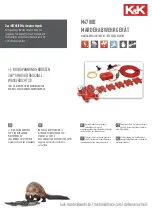
5-194
L60 LINE PHASE COMPARISON SYSTEM – INSTRUCTION MANUAL
GROUPED ELEMENTS
CHAPTER 5: SETTINGS
5
The phase comparison tripping scheme menu provides the main setup for the phase comparison relay.
See the Application of Settings chapter for more information on individual settings.
87PC SCHEME SELECT
— Selects the phase comparison element scheme logic as follows:
2TL-TR-SPC-2FC — Two-terminal line, permissive tripping, single phase comparison, two frequency channel.
2TL-BL-SPC-2FC — Two-terminal line, blocking scheme, single phase comparison, two frequency channel.
2TL-UB-DPC-2FC — Two-terminal line, unblocking, dual phase comparison, two frequency channel (FSK PLC only);
scheme cannot be used for breaker-and-a-half applications.
2TL-TR-DPC-3FC — Two-terminal line, permissive tripping, dual phase comparison, three frequency channel.
2TL-BL-DPC-3FC — Three-terminal line, blocking scheme, dual phase comparison, three frequency channel.
3TL-TR-SPC-2FC — Three-terminal line, permissive tripping scheme, single phase comparison, two frequency channel
carrier to two other terminals.
3TL-BL-SPC-2FC — Three-terminal line, blocking scheme, single phase comparison, two frequency channel carrier to
two other terminals.
3TL-TR-DPC-3FC — Three-terminal line, permissive tripping scheme, dual phase comparison, three frequency channel
carrier to two other terminals.
3TL-BL-SPC-3FC — Three-terminal line, blocking scheme, dual phase comparison, three frequency channel carrier to
two other terminals.
87PC BLOCK
— Selects a Flexlogic operand that blocks operation of the phase comparison scheme (for example, an
operand that indicates operation of a communications channel failure detector).
87PC SIGNAL SOURCE
— Selects whether current is supplied from one current source (either single-breaker CT application or
dual-breakers with CTs summed externally) or from two separate sources (breaker-and-a-half or ring configurations),
where currents from both CTs are fed into the L60 individually.
87PC SIGNAL
— A mixed I_2 – K
×
I_1 signal, mixed I_1+I_2 / K signal, or single 3I_0 signal can be chosen as the operating
signal for the FDH and FDL detectors and positive/negative square pulses generation. The constant K in the mixed
excitation signal is adjustable.
87PC MIXED SIGNAL K
— Selects the K factor used in the mixed excitation operating signals I_2 – K
×
I_1 and I_1+I_2 / K. For
the mixed I_1+I_2 / K mode, the setting range is limited from 0.08 to 0.25.
87PC MIXED SIGNAL REF ANGLE
— This setting applies exclusively to the negative-sequence mixed mode operating current
(“Mixed I_2-K*I_1”) and specifies a leading angular shift for the originally developed operating signal. The operating signal
is always developed taking phase A as reference for calculating symmetrical components. This setting can be used to
control the angular position of the operating current with respect to the voltage of any phase that can be used by the line
carrier in a particular application. This allows minimizing the impact of positive corona on dependability of single-
comparison blocking schemes. Effectively this setting shifts the transmitted pulses in time with the intent to minimize—for
87PC CHNL LOSS TRIP
WINDOW: 0 msec
Range: 0 to 500 ms in steps of 1
87PC HIGH-SPEED TRIP
CONTACT 1: Off
Range: Off, available contact outputs
87PC HIGH-SPEED TRIP
CONTACT 2: Off
Range: Off, available contact outputs
87PC TARGET:
Self-Reset
Range: Self-Reset, Latched, Disabled
87PC EVENTS:
Disabled
Range: Disabled, Enabled
A two-frequency channel (2FC) can be either amplitude modulated (AM) on-off carrier or a high-low frequency shift
keying (FSK) system.
In blocking schemes, the open breaker echo element must be disabled.















































